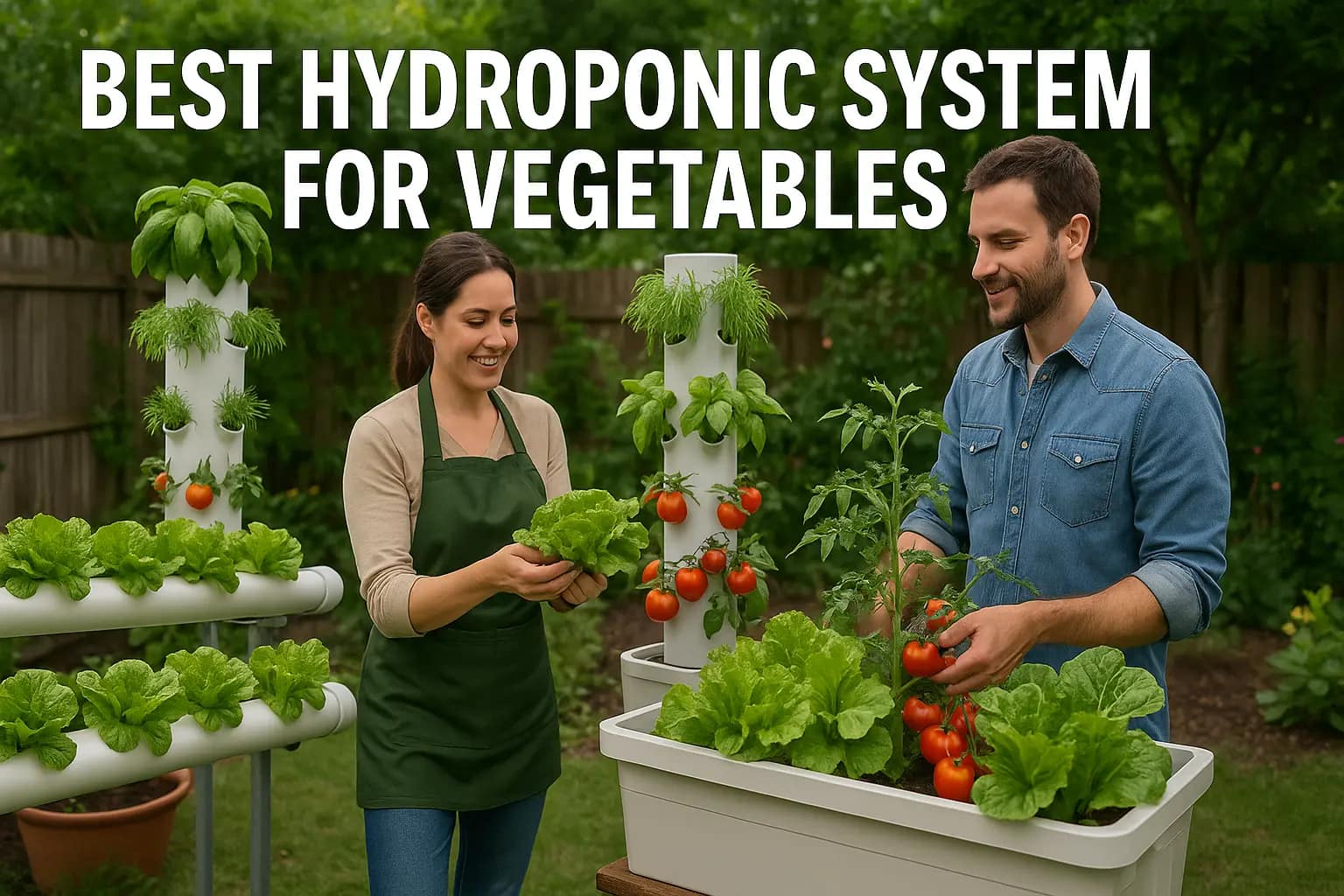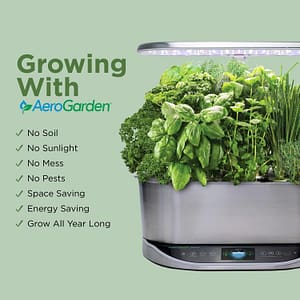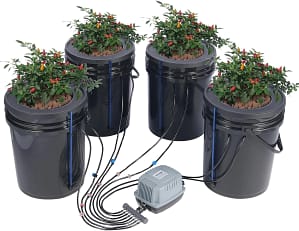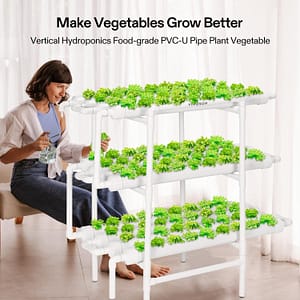In this comprehensive guide, I’ll share my insights on the best hydroponic system for vegetables, helping you choose the perfect setup for your home garden.
Table of Contents
- 1 Understanding Hydroponic Systems
- 2 1. AeroGarden Bounty Elite Best Hydroponic System for Beginners
- 3 2. General Hydroponics EcoGrower Drip Hydroponic System for Vegetables
- 4 3. VIVOSUN Hydroponic Grow Kit
- 5 4. PowerGrow Deep Water Culture (DWC) Hydroponic System for Vegetables
- 6 5. Tower Garden Vertical Aeroponic Growing System
- 7 How to Choose the Best Hydroponic System for Vegetables
- 8 Tips for Success with Your Hydroponic System for Vegetables
- 9 People Also Asked
- 9.1 What is the easiest vegetable to grow hydroponically?
- 9.2 Can tomatoes be grown hydroponically?
- 9.3 How often should I change the water in my hydroponic system for vegetables?
- 9.4 Do hydroponic vegetables grow faster than soil-grown vegetables?
- 9.5 What lighting is best for an indoor hydroponic system for vegetables?
- 9.6 Can I use tap water for hydroponics?
- 9.7 How much does it cost to set up a basic hydroponic system for vegetables?
- 9.8 Is the hydroponic system for vegetables organic?
- 9.9 Can I grow root vegetables hydroponically?
- 9.10 How do I prevent algae growth in my hydroponic vegetables system?
- 10 Key Takeaways:
- 11 Ready to Start Growing Hydroponic Vegetables?
Understanding Hydroponic Systems
Hydroponics is a method of cultivation that uses nutrient-rich water solutions instead of soil, allowing plants to grow faster and more efficiently. There are several types of growing hydroponic vegetables systems, each with its own advantages:
- Deep Water Culture (DWC): Plants are suspended in nutrient-rich water, with their roots directly submerged.
- Nutrient Film Technique (NFT): A thin film of nutrient solution flows over the roots continuously.
- Ebb and Flow (Flood and Drain): Plants are periodically flooded with nutrient solution, which then drains away.
- Drip Systems: Nutrient solution is dripped onto the base of each plant.
- Aeroponics: Roots are misted with nutrient solution in an air or mist environment.
- Vertical Hydroponic Systems: Plants are stacked vertically to maximize space efficiency.
Now, let’s explore some of the best hydroponic systems for vegetables at home.
1. AeroGarden Bounty Elite Best Hydroponic System for Beginners
The AeroGarden Bounty Elite is an excellent choice for the best hydroponic system for beginners and experienced gardeners alike. This sleek, countertop system is perfect for people with limited space or those who want to grow vegetables year-round indoors.
Key Features:
- Accommodates up to 9 plants
- Full spectrum 45-watt LED grow light
- Touch screen control panel with Wi-Fi connectivity
- Automatic reminders for water and nutrient additions
The AeroGarden Bounty Elite stands out because of its user-friendly interface and automated features. The touch screen control panel makes it easy to watch your plants’ progress, while the Wi-Fi connectivity allows you to check on your garden remotely through a smartphone app.
I’ve had great success growing cherry tomatoes, lettuce, and herbs in my AeroGarden. The LED grow lights are particularly impressive, providing the perfect spectrum for robust plant growth.
However, it’s worth noting that larger vegetables like full-sized tomatoes or peppers may outgrow this system quickly.
When using the AeroGarden Bounty Elite, start with fast-growing herbs and leafy greens to get a feel for the system before moving on to more challenging crops. This approach will help you build confidence and understand the nuances of hydroponic gardening.
The system’s compact size makes it ideal for apartment dwellers or those with limited outdoor space. You can easily place it on a kitchen counter or in a small corner of your living room, bringing fresh, homegrown vegetables right to your fingertips.
One of the most significant advantages of the AeroGarden is its ease of use. The automated reminders for water and nutrient additions take the guesswork out of plant care, making it an excellent choice for busy people or those new to gardening.
2. General Hydroponics EcoGrower Drip Hydroponic System for Vegetables
For those looking to grow larger vegetables or a greater variety of plants, the General Hydroponics EcoGrower Drip Hydroponic System for Vegetables is an excellent choice. This system uses a drip irrigation method to deliver nutrients directly to the plant roots.
 Key Features:
Key Features:
- 17-gallon reservoir
- Accommodates up to 8 large plants
- Includes air pump and stone for oxygenation
- Expandable design for larger setups
The EcoGrower’s versatility is one of its standout features. The 17-gallon reservoir provides enough space for nutrient solution, reducing the frequency of refills.
This larger capacity makes it ideal for growing medium to large-sized vegetables that need more water and nutrients.
The system’s design allows for easy expansion, making it ideal for gardeners who want to start small and gradually increase their hydroponic setup. You can begin with a single unit and add more as you gain experience and confidence in your hydroponic gardening skills.
I’ve successfully grown tomatoes, cucumbers, and even small melons in this system. The drip irrigation method confirms that each plant receives an adequate amount of nutrients, promoting healthy growth and bountiful harvests.
One potential drawback is that this system needs more hands-on maintenance compared to fully automated options like the AeroGarden. You’ll need to watch pH levels, nutrient concentrations, and water levels regularly.
However, this hands-on approach can be rewarding for those who enjoy being more involved in the growing process.
The EcoGrower’s design allows for excellent oxygenation of the nutrient solution, thanks to the included air pump and stone. This feature promotes healthy root development and helps prevent issues like root rot, which can be a concern in some hydroponic systems.
When using the EcoGrower, it’s essential to pay attention to the specific needs of each plant. Some vegetables may need more frequent nutrient solution changes or adjustments to the drip rate.
Experimenting with different plant varieties and keeping detailed records of your results will help you improve your system over time.
3. VIVOSUN Hydroponic Grow Kit
If you’re interested in trying the Nutrient Film Technique (NFT), the VIVOSUN Hydroponic Grow Kit is an excellent entry point. This system is designed for growing leafy greens and herbs efficiently.
 Key Features:
Key Features:
- 36 plant sites
- Adjustable flow rate
- Includes water pump and tubing
- Lightweight and easy to assemble
The VIVOSUN NFT system stands out for its simplicity and effectiveness. The continuous flow of nutrient solution over the roots promotes rapid growth, especially for leafy vegetables like lettuce and spinach.
I’ve found that this system produces crisp, flavorful greens in a remarkably short time.
One of the advantages of this system is its space efficiency. The vertical design allows you to grow a large number of plants in a small footprint, making it ideal for urban gardeners or those with limited growing space.
You can easily fit this system in a spare room, on a balcony, or even in a small greenhouse.
The adjustable flow rate is a key feature of the VIVOSUN system. It allows you to fine-tune the nutrient delivery based on the specific needs of your plants.
For example, young seedlings may need a gentler flow, while mature plants can benefit from a stronger current.
When using the NFT system, it’s crucial to maintain a consistent flow of nutrient solution. Any interruptions in the flow can quickly lead to plant stress or even crop failure.
Regular checks of the pump and tubing are essential to confirm smooth operation.
The VIVOSUN system is particularly well-suited for growing a variety of lettuce types, herbs like basil and cilantro, and other leafy greens such as kale and Swiss chard. These plants thrive in the NFT environment, often reaching maturity faster than they would in traditional soil-based gardens.
While the NFT system excels at producing leafy greens and herbs, it may not be the best choice for larger fruiting vegetables like tomatoes or peppers. These plants typically need more root space and a different nutrient balance than what the NFT system provides.
When starting with the VIVOSUN NFT system, begin with fast-growing crops like lettuce or arugula. This approach will allow you to see quick results and gain confidence in using the NFT system.
As you become more familiar with the system’s operation, you can experiment with a wider variety of plants and growing techniques.
4. PowerGrow Deep Water Culture (DWC) Hydroponic System for Vegetables
For those who want to try their hand at Deep Water Culture, the PowerGrow DWC Hydroponic System for Vegetables offers a simple yet effective solution. This system is great for growing medium to large-sized plants.
Key Features:
- 5-gallon FDA-approved buckets
- 6-inch net pots for larger plants
- Air pump and air stones included
- Expandable design for multiple buckets
The PowerGrow DWC system stands out for its simplicity and scalability. The large buckets provide enough space for root development, while the air stones confirm proper oxygenation of the nutrient solution.
This combination creates an ideal environment for robust plant growth.
I’ve had great success growing tomatoes, peppers, and even small eggplants in this system. The deep water culture method allows for rapid nutrient uptake, resulting in faster growth and higher yields compared to traditional soil gardening.
One of the key advantages of the PowerGrow DWC system is its flexibility. You can start with a single bucket and expand your setup as your skills and ambitions grow.
This modular approach makes it easy to experiment with different plant varieties or to scale up your production without a significant upfront investment.
The 6-inch net pots are particularly well-suited for larger plants with extensive root systems. They provide enough support for the plant while allowing the roots to grow freely into the nutrient solution below.
When using the PowerGrow DWC system, it’s crucial to maintain the proper water temperature. In warmer climates, you may need to use a water chiller to prevent the nutrient solution from becoming too warm, which can lead to root problems.
Alternatively, you can place the buckets in a cool, shaded area or use insulation to help regulate the temperature.
Regular monitoring of pH levels and nutrient concentrations is essential for success with the DWC system. Invest in a good quality pH meter and EC (electrical conductivity) meter to confirm your plants are receiving the optimal nutrient balance.
One potential challenge with DWC systems is the risk of power outages. Since the plants rely on the air pump for oxygen, a prolonged power failure can quickly lead to root damage.
Consider having a backup power source or battery-operated air pump on hand for emergencies.
The PowerGrow DWC system is particularly well-suited for plants that thrive in high-oxygen environments. In addition to tomatoes and peppers, you can successfully grow leafy greens, herbs, and even some root vegetables like carrots or radishes (with suitable modifications to the net pots).
5. Tower Garden Vertical Aeroponic Growing System
If you’re looking to maximize your growing space, the Tower Garden Vertical Aeroponic Growing System is an excellent choice. This system allows you to grow up to 20 plants vertically, making it perfect for small spaces.
Key Features:
- Aeroponic technology for faster growth
- Includes LED grow lights for indoor use
- Automated timer for lights and pump
- Compact design for balconies or patios
The Tower Garden’s vertical design is invaluable for urban gardeners or those with limited outdoor space. I’ve been impressed by how much I can grow in such a small footprint.
The aeroponic misting system delivers nutrients directly to the roots, promoting rapid growth and effective resource use.
One of the standout features of the Tower Garden is its versatility. It can be used both indoors and outdoors, thanks to the included LED grow lights. Learn more about the best LED lighting systems for growing plants indoors.
This flexibility allows for year-round growing, regardless of climate or season.
I’ve successfully grown a wide variety of vegetables in my Tower Garden, including lettuce, kale, cherry tomatoes, and even small peppers. The vertical design also makes harvesting easy, as you can simply pluck leaves or fruits at eye level.
The automated timer for lights and pump takes much of the guesswork out of plant care. This feature is particularly useful for busy people or those new to hydroponic gardening.
The system confirms that your plants receive consistent light and nutrient delivery, even when you’re away from home.
When using the Tower Garden, it’s important to consider the weight distribution of your plants. While the system can support a variety of vegetables, larger fruiting plants like full-sized tomatoes or cucumbers may strain the structure.
Focus on compact varieties or plants with lighter fruits to confirm the best results.
The aeroponic misting system used in the Tower Garden is highly effective in terms of water and nutrient use. The fine mist delivers nutrients directly to the plant roots, reducing waste and promoting faster growth compared to traditional soil-based gardening.
One potential challenge with the Tower Garden is managing the nutrient solution pH and concentration. As the plants grow and consume nutrients, you’ll need to regularly check and adjust the solution to maintain optimal growing conditions.
Investing in a good quality pH meter and following the manufacturer’s guidelines for nutrient management will help confirm success.
The Tower Garden is particularly well-suited for growing leafy greens and herbs. These plants thrive in the aeroponic environment and can be harvested multiple times, providing a continuous supply of fresh produce.
Experiment with different varieties of lettuce, kale, spinach, and herbs like basil, cilantro, and parsley to find your favorites.
Consider companion planting in your Tower Garden to maximize yields and naturally deter pests. For example, try growing basil alongside tomatoes to enhance flavor and repel certain insects.
The vertical design allows for creative combinations that can benefit multiple plants simultaneously.
Read our article on top water distillers for unmatched plant growth.
How to Choose the Best Hydroponic System for Vegetables
When selecting the best hydroponic system for vegetables, consider the following factors:
- Available space: Determine how much room you have for your hydroponic setup.
Vertical systems like the Tower Garden are great for small spaces, while larger systems like the EcoGrower need more room.
- Types of vegetables: Different systems are better suited for certain types of plants.
Consider what you want to grow and choose a system that can accommodate those plants.
- Experience level: Some systems, like the AeroGarden, are more beginner-friendly, while others need more hands-on management.
- Budget: Hydroponic systems range from affordable to high-end options.
Consider your initial investment and ongoing costs for nutrients and electricity.
- Maintenance requirements: Consider how much time you can dedicate to system upkeep.
Fully automated systems need less daily attention but may be more expensive.
Tips for Success with Your Hydroponic System for Vegetables
To confirm the best results with your hydroponic system for vegetables, keep these tips in mind:
- Maintain proper pH levels (usually between 5.5 and 6.5) for optimal nutrient uptake.
- Use high-quality hydroponic nutrients specifically formulated for vegetables.
- Monitor water temperature to keep it between 65-75°F (18-24°C) for most vegetables.
- Ensure adequate lighting, whether using natural sunlight or grow lights.
- Keep your system clean and perform regular maintenance to prevent issues.
Hydroponic system for vegetables offer an exciting and effective way to grow vegetables at home. Whether you’re a beginner or an experienced gardener, there’s a hydroponic system for vegetables out there that’s perfect for your needs. By choosing the right system and following best practices, you’ll be well on your way to harvesting fresh, homegrown vegetables year-round.
People Also Asked
What is the easiest vegetable to grow hydroponically?
Leafy greens like lettuce, spinach, and kale are among the easiest vegetables to grow hydroponically. They have short growth cycles and thrive in most hydroponic systems.
Can tomatoes be grown hydroponically?
Yes, tomatoes can be grown hydroponically. They do particularly well in systems like Deep Water Culture (DWC) or drip systems that can support larger plants.
How often should I change the water in my hydroponic system for vegetables?
The frequency of water changes depends on your system size and the plants you’re growing. Generally, you should change the nutrient solution every 2-3 weeks or when the EC (electrical conductivity) levels drop significantly.
Do hydroponic vegetables grow faster than soil-grown vegetables?
In many cases, yes. Hydroponic vegetables often grow 30-50% faster than soil-grown plants because of optimized nutrient delivery and growing conditions.
What lighting is best for an indoor hydroponic system for vegetables?
LED grow lights are often considered the best for an indoor hydroponic system for vegetables because of their energy efficiency and ability to provide a full spectrum of light for plant growth.
Can I use tap water for hydroponics?
While tap water can be used, it’s important to test its pH and mineral content first. Some tap water may contain chlorine or other elements that could affect plant growth.
How much does it cost to set up a basic hydroponic system for vegetables?
The cost of a basic hydroponic system for vegetables can range from $50 for a small, DIY setup to $500 or more for a larger, commercial system. Ongoing costs for nutrients and electricity should also be considered.
Is the hydroponic system for vegetables organic?
While hydroponic system for vegetables are grown without soil, they are not automatically considered organic. To be certified organic, they must be grown using approved organic nutrients and practices.
Can I grow root vegetables hydroponically?
Yes, root vegetables like carrots, radishes, and beets can be grown hydroponically, but they need specialized systems or modifications to standard setups to accommodate their growth patterns.
How do I prevent algae growth in my hydroponic vegetables system?
To prevent algae growth, keep your system clean, use opaque containers to block light from the nutrient solution, and confirm proper circulation and oxygenation of the water.
Key Takeaways:
- Consider your space, experience level, and vegetable preferences when choosing a system.
- Maintain proper pH levels, nutrients, and water temperature for optimal growth.
- Regular maintenance is crucial for the success of your hydroponic garden.
Ready to Start Growing Hydroponic Vegetables?
Choosing the best hydroponic system for vegetables depends on your goals, space, and experience. For the best hydroponic system for beginners, we recommend the AeroGarden Bounty Elite. If you’re aiming for larger yields or fruiting veggies, opt for the EcoGrower or PowerGrow DWC. Want something sleek and vertical? The Tower Garden is a must-have.
Start growing hydroponic vegetables fresher, healthier veggies from home—no green thumb required. Explore our top picks and transform your space into a thriving hydroponic vegetables garden today!




